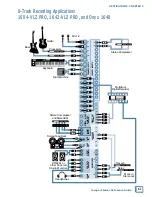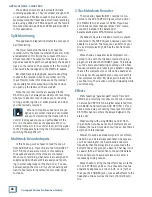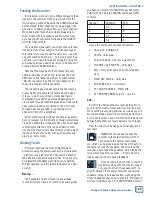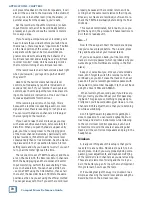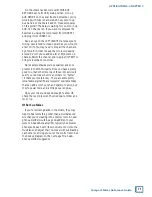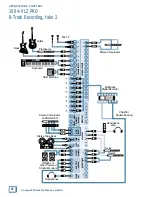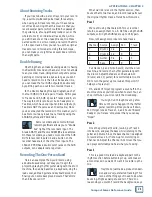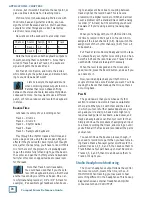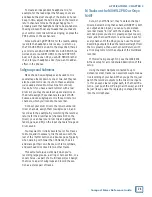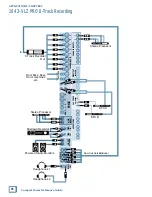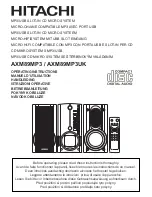
69
Compact Mixer Reference Guide
APPLICATIONS: CHAPTER 2
Feeding the Recorder
In this setup, we’re using two different ways to feed
signals to the recorder. Tracks 1-4 are fed from the
four subgroup outputs. By using the ASSIGN switches
and PAN pots, those tracks can receive a signal indi-
vidually or in odd-even pairs from any input channel.
We’ve dedicated Tracks 5-8 to what’s plugged into
mixer Channels 5-8 (keyboard and drum machine)
by connecting those recorder inputs to the DIRECT
OUTs for Channels 5-8.
For a cleaner signal path, you might choose to feed
tracks 1-4 from direct outputs. The disadvantage of
this is that if you want to use the same mic —say the
one connected to Channel 1— to record a second vo-
cal track, you’ll need to re-patch things. By using the
sub outputs, all you need to do is turn the PAN pot or
press a different ASSIGN button.
Note that the Onyx has Direct outputs for every
channel, but they’re not on 1/4" jacks like the VLZ-
PRO mixers, but rather on a 25 pin D-subminiature
(DB-25) connector. See Mixer Tips, Chapter 9, for
the wiring diagram of this connector.
There’s nothing sacred about this channel layout,
but we had to pick something to talk about. Adapt
it to your own choice of instruments and tracks.
Incidentally, we show the guitar and bass going to
Line inputs through outboard processors. They could
have just as well been connected to the mic inputs
through direct boxes (DIs) or by placing micro-
phones in front of the amplifi ers.
Direct electric guitar without the help of an ampli-
fi er or processor is kind of wimpy (though sometimes
nice when added to a miked amplifi er, but direct bass
is often quite effective. This is a good time to men-
tion that the Onyx mixers have two direct instrument
inputs on Channels 1 and 2. Just push a button and
plug in an instrument.
Making Tracks
First we’ll describe the most straightforward
procedure using the system as shown in the diagram
– eight sources, eight tracks. Then we’ll do another
take and show you some studio tricks. First, to avoid
an inadvertent feedback path while you’re getting
things organized, pull the faders fully down on Chan-
nels 1-8.
Ready......
The keyboard and drum machine are already
routed directly to tracks. To record the vocals, guitar
and bass, you must fi rst ASSIGN those channels to
SUB OUTs 1-4 using the ASSIGN buttons and PAN
controls.
Channel
ASSIGN
PAN
1
1-2
L
2
1-2
R
3
3-4
L
4
3-4
R
Here’s the rest of your pre-fl ight checklist:
•
Chan 9-16 - ASSIGN L-R
•
TRIMs - Unity Gain
•
Chan 9-16 PANs - where you want them
•
CHANNEL 9-16 FADERs – Unity Gain
•
EQs – Flat (all knobs in their centered posi-
tion)
•
MAIN MIX FADER – Unity Gain
•
SUB FADERs 1-4 – Unity Gain
•
CTL ROOM SOURCE – MAIN MIX
•
CTL ROOM/PHONES volume – up a bit
Set.....
Perform the Famous Mackie Level-Setting Proce-
dure for all the instruments and mics. Don’t be shy.
When setting levels, sing and play as loud as you will
during a real take. If you’ll be recording parts one at
a time, set levels one at a time. If the whole band will
be playing together, set levels during a run-through.
Now the mixer will be happy, but what about the
recorder?
WARNING: You’re about to send the
recorder outputs to the mixer, which is
connected to the control room speak-
ers, which can be picked up by the mics if they’re in
the same room as the speakers. The mics feed the
recorder, which feeds the speakers, which feeds the
mics, which feeds the recorder.. . . This is why the
loud squeal you hear is called feedback.
If you’re recording with mics in the Con-
trol Room (along with the monitor speak-
ers), you must turn the speakers off – re-
ally off! Switch off the power amplifi er or powered
speakers. Since, in this application, we’re using the
mixer’s headphone jack as a cue feed for the players,
while turning down the CTL ROOM/PHONES control

